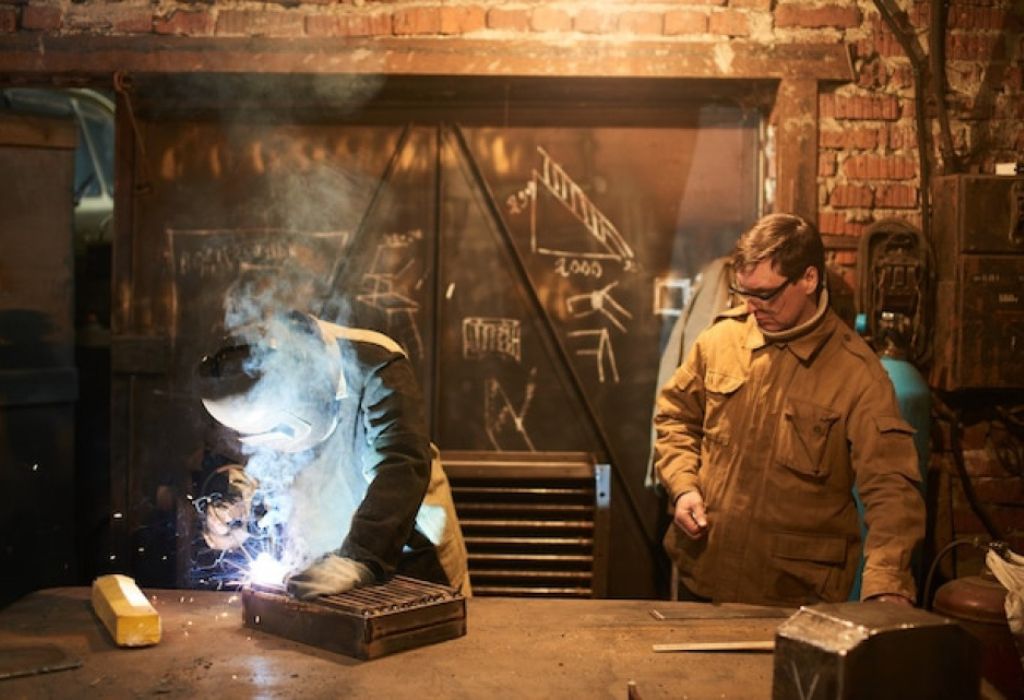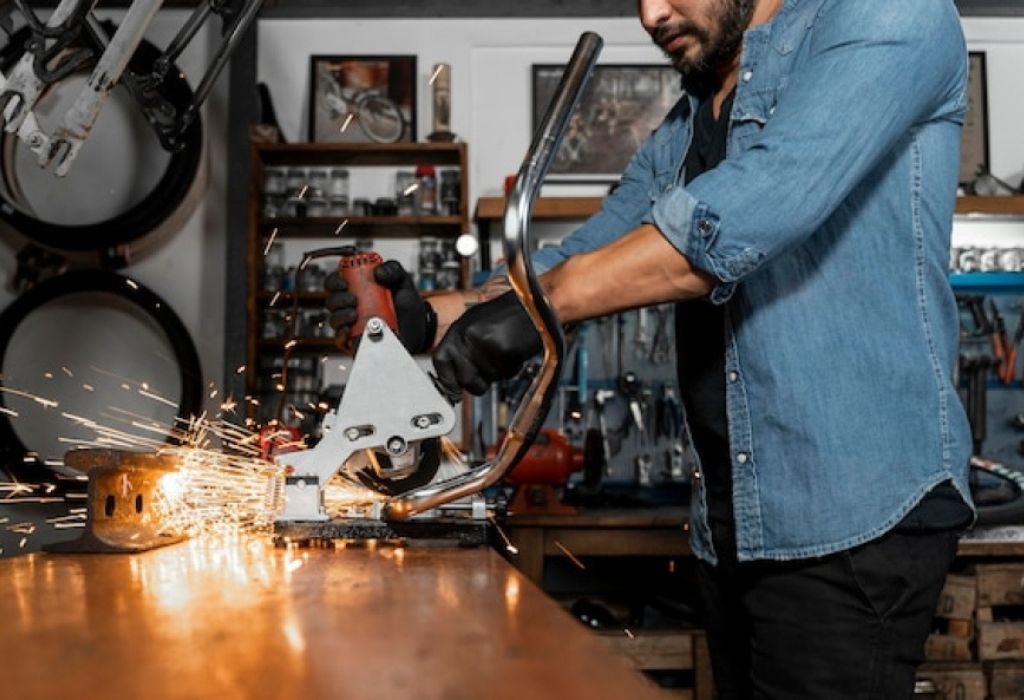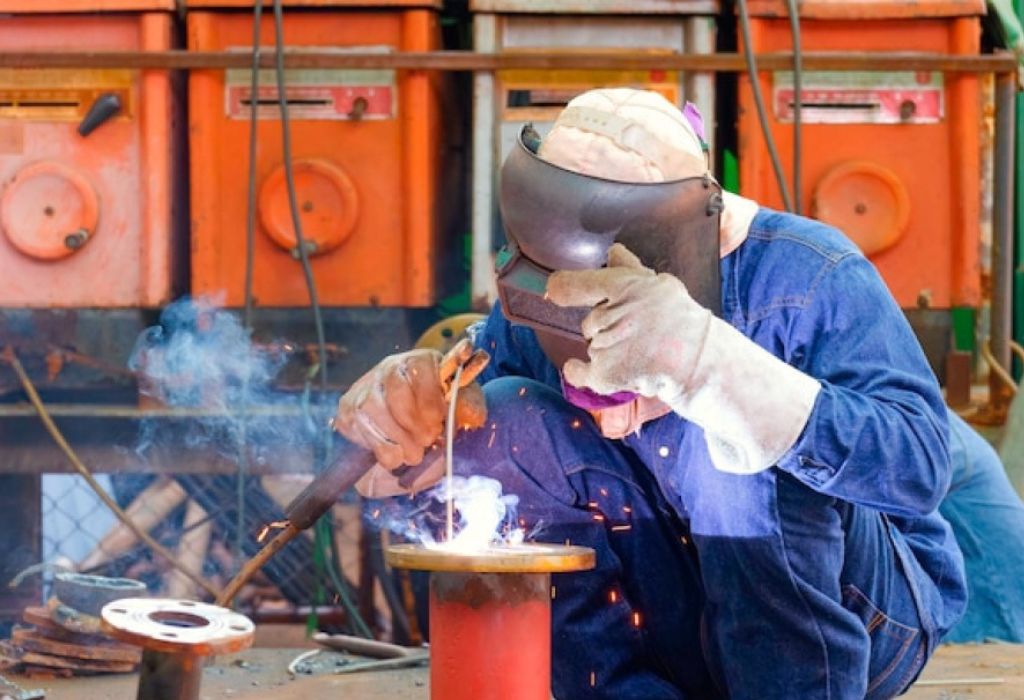team hisses through a cooling vessel while a crew races the clock to bring a power unit back online. The craft holding that schedule together is boilermaker welding.
The role blends high-heat welding with rigging, layout, and code work on pressure vessels in plants and refineries. Curiosity grows because few careers mix this much precision with this much scale.
Pay and progression motivate many to explore how to become a boilermaker welder. The median annual wage reached $73,340 in May 2024, confirming strong returns for top skills. Bureau of Labor Statistics
Training is accessible through earn-while-you-learn apprenticeships. NABTU reports 1,900 training centers that train 71 percent of construction apprentices across North America, creating a clear entry lane without tuition debt. NABTU
Daily work goes beyond running a bead. Crews read blueprints, fit heavy sections, and weld with SMAW, GTAW, and FCAW to code quality for boilers and other pressure vessels.
Safety is nonnegotiable because much of the job happens in confined spaces with hot work controls and rigorous procedures. Discipline around permits, ventilation, and PPE defines long careers. OSHA+1
This guide maps every step in plain language so decisions come easier. It shows the credentials, skills, timelines, and hiring channels that move trainees into reliable outage and turnaround work.
Begin with a clear picture of the job scope before committing to training. The next section explains what a boilermaker welder actually does, so each requirement makes sense.
What a Boilermaker Welder Actually Does

Boilermaker welders assemble, install, and repair boilers and other pressure vessels in power plants, refineries, shipyards, and heavy industry. Daily work blends welding, rigging, layout, fit-up, testing, and documentation to code quality. Bureau of Labor Statistics
Core processes include SMAW, GTAW/TIG, and FCAW across carbon and alloy steels. Cutting and prep rely on oxy-fuel, grinding, and precise blueprint reading aligned to code practices.
Jobsites range from elevated steel to tight, permit-required confined spaces inside shells and drums. Hot-work permits, ventilation, and PPE are enforced under OSHA welding and confined space standards. OSHA+1
Understanding this scope clarifies how to become a boilermaker welder and which skills to prioritize. The BLS overview summarizes typical environments and duties. Bureau of Labor Statistics
What’s the difference between a boilermaker and a welder?
Boilermakers build and maintain complete vessel systems from layout to testing, with welding as a core skill, while welders primarily join metals on varied projects.
Which welding processes are used most on the job?
SMAW is the field workhorse, with GTAW/TIG and FCAW used for precision, position, or alloy work.
Is blueprint reading required?
Yes, isometric drawings and shop prints drive layout, fit-up, and verification of tolerances for pressure vessels.
Why are safety rules so strict for this craft?
Work often happens at height or inside vessels, so OSHA hot-work and confined space rules control fire, fumes, and atmosphere hazards. OSHA+1
What other tasks happen besides welding?
Rigging and lifting, tube rolling, hydrostatic testing, torqueing, NDT coordination, and code documentation keep systems safe and compliant.
Step-by-Step Path: How to Become a Boilermaker Welder
Step 1 — Finish High School or Equivalent
A high school diploma or GED is the baseline for most registered programs. Math, blueprint reading, shop, and basic physics build a foundation used daily.
Step 2 — Choose Your Entry Route
Route A is a union apprenticeship that pairs paid on-the-job training with related instruction. Route B is a welding-focused trade school or community college that can feed into apprenticeship or entry roles. Boilermakers Union
Step 3 — Meet Apprenticeship Requirements
The national standard spans about four years with a minimum of 6,000 field hours and 576 classroom hours across the program. Many locals specify at least 144 hours of classroom or shop training per year. bnap+1
Step 4 — Build Welding Proficiency and Pass Tests
Expect process and position tests such as 3G, 4G, or 6G pipe depending on the job. Contractors or locals re-test to current procedures before dispatch.
Step 5 — Learn Rigging, Fitting, and Blueprint Reading
Boilermakers align shells, heads, and nozzles, set tubes, and rig heavy components safely. Accurate measuring, layout, and fit-up are nonnegotiable for code quality.
Step 6 — Master Safety and Compliance
Confined space entry, ventilation, fire prevention, and hot-work permits are daily realities. OSHA welding and confined space standards anchor procedures sitewide. OSHA+1
Step 7 — Complete the Program and Upgrade to Journeyman
Finish the hours, pass all related studies, and maintain qualifications to move to journeyman status. Continuous training keeps skills current for outage and turnaround seasons. bnap
How long does it take to become a journeyman boilermaker welder?
Plan on about four years with 6,000 field hours and structured classroom time. bnap
Is a GED acceptable for entry?
Most registered apprenticeships accept a GED, but local requirements should be confirmed.
Do programs pay while training?
Union apprenticeships are earn-while-you-learn with progressive wages and benefits. NABTU
Will trade school alone qualify someone as a boilermaker?
School can accelerate welding skills, but the recognized path into the craft is a registered apprenticeship with field hours and related instruction. Boilermakers Union
Are weld tests portable from one site to another?
Employers often require on-site performance qualification, so expect to re-test for each contractor or project.
Costs, Pay, and Job Outlook

Registered apprenticeship is typically tuition-free and includes wages and benefits. Debt-free training is a hallmark of the building trades system. NABTU
According to the Occupational Outlook Handbook, the median annual wage for boilermakers was $73,340 in May 2024. Employment is projected to decline 2 percent from 2024 to 2034, yet openings will continue due to retirements and transfers. Bureau of Labor Statistics
OEWS data show detailed percentile wages and mean wages for boilermakers, which helps set expectations for experience levels and regions. Review current national estimates and percentile ranges when comparing offers. Bureau of Labor Statistics+1
Outage and turnaround work can add overtime, per diem, and travel incentives. Locals and contractors post these calls based on power plant and refinery schedules.
How much do boilermaker welders earn starting out?
Pay scales vary by local and region, but OEWS tables and local agreements provide reliable baselines for early career wages. Bureau of Labor Statistics
What is the long-term outlook for this craft?
Overall headcount may dip while replacement needs create steady openings, and large industrial projects still require vessel work. Bureau of Labor Statistics
Where do the highest wages appear?
Higher percentiles often track with travel, specialty qualifications, and heavy industrial markets documented in OEWS data. Bureau of Labor Statistics
Does apprenticeship cost money?
Programs are typically tuition-free, with earnings paid during training under registered standards. NABTU
Are benefits included during apprenticeship?
Union programs include progressive wage steps and benefits that grow toward journeyman scales. Boilermakers Union
Tools, Certifications, and Skills to Stand Out
Common tools include SMAW stingers, TIG torches, wire feeders, oxy-fuel rigs, grinders, mag drills, chainfalls, and come-alongs. Precision measuring tools and torque equipment support tight tolerances.
Competitive candidates document process qualifications aligned to employer procedures and codes. Extra strengths include tube rolling, hydrostatic testing, and NDT familiarity supported in national training. bnap
Soft skills help crews finish on schedule under tight outage windows. Clear communication, situational awareness, and disciplined documentation are valued.
Which welding process should come first?
SMAW is the field staple for structural and vessel joints, then GTAW and FCAW for precision or alloy work.
Do multiple certifications help with dispatch?
Yes, maintaining current process and position quals raises eligibility for more calls.
Is tube work a separate specialty?
Tube welding and rolling are common refinery and power skills, and they are taught within the national program. bnap
Does QA or inspection experience matter?
Understanding NDT, hold points, and documentation speeds acceptance and reduces rework.
What safety tickets are useful beyond OSHA basics?
Site owners may require site-specific cards and additional modules, which locals outline before dispatch.
Where to Apply and How to Get Hired
Start with the International Brotherhood of Boilermakers to locate a local lodge and learn how applications are handled. The recruiting and join-us pages explain benefits, timelines, and entry windows. Boilermakers Union+1
Use Apprenticeship.gov to search open programs or sponsors and to apply directly when postings appear. State apprenticeship portals add region-specific details and contacts. Apprenticeship.gov+1
If trade school is a stepping stone, connect its placement office with nearby locals and contractors. Document weld tests, instructor references, and any shop or field hours earned.
How competitive are apprenticeship intakes?
Cohorts are limited and may open only a few times per year, so early, complete applications help.
What goes in an application packet?
Expect proof of education, ID, weld tests where available, and readiness for a physical, drug test, and interviews as directed by the local. Boilermakers Apprenticeship
Where are official job and apprenticeship listings posted?
Use Apprenticeship.gov’s job finder and local lodge announcements for current openings. Apprenticeship.gov
Can military veterans use benefits during training?
Many programs allow GI Bill benefits during apprenticeship through recognized sponsors. helmetstohardhats.org
Is relocation required to stay busy?
Traveler status can increase opportunities during seasonal outages, and locals guide members on portability.
Safety, Codes, and Compliance You Will Live By
Welding and cutting require fire prevention, fire watch, and housekeeping controls detailed in OSHA’s welding standard. These rules govern cylinders, ventilation, and ignition source management. OSHA
Confined space entry procedures protect crews inside drums, tanks, and vessels. Atmosphere testing, attendants, permits, and rescue plans are defined in the confined space standard and companion materials. OSHA+1
Site owners layer company rules on top of federal standards. Crews follow hot-work permits, lockout procedures, and documented hold points for inspections.
What is a hot-work permit and why is it needed?
It is written authorization to perform welding or cutting with required fire prevention and monitoring based on OSHA’s welding standard. OSHA
Who watches during confined space entry?
A trained attendant remains outside with continuous communication and a rescue plan as required by the standard. OSHA
Are all vessels automatically permit spaces?
Spaces are treated as permit-required until hazards are evaluated and controlled under specific procedures. eCFR
Which other rules often apply on industrial sites?
Owner requirements and consensus standards supplement OSHA, and site orientations outline the full stack. OSHA
Where can the standards be reviewed quickly?
OSHA provides consolidated welding and confined space pages that link to the regulations and guidance. OSHA
Career Paths After Journeyman

Journeymen can specialize as pressure welders, tube specialists, rigging leads, or foremen. Others move into QA, inspection, or training roles where documentation and mentoring matter.
Travel and outage work suit those who enjoy fast schedules and higher earning potential. Leadership tracks emerge for members who communicate clearly and drive safe productivity. Boilermakers Union
What are common specializations within the trade?
Pressure vessel welding, tube rolling, advanced rigging, and supervision are frequent routes.
Can experience transfer to other industries?
Shipbuilding, petrochemical, and heavy fabrication value the same skills and safety discipline.
How do earnings rise after qualification?
Stack process qualifications, accept travel calls, and pursue foreman or QA roles tied to major outages.
Does training end at journeyman?
No, locals emphasize continuous upgrades and requalification to stay dispatch-ready. bnap
What long-term opportunities exist outside field construction?
Fabrication shops, inspection agencies, and training centers tap seasoned craft professionals.
Conclusion
A clear plan makes how to become a boilermaker welder achievable. Start with a diploma or GED, enter a registered apprenticeship, build multi-process welding skills, live the safety rules, and keep upgrading qualifications. bnap+1
Strong training networks, documented wages, and steady replacement openings create a durable pathway. Explore your local lodge, review Apprenticeship.gov listings, and prepare a complete application to begin.

I’m Darrell Julian, the founder, lead writer, and hands-on welding enthusiast behind ArcWeldingPro.com. With more than 15 years of real-world welding experience, I created this platform to share what I’ve learned in the field, in the shop, and in the heat of the arc.


